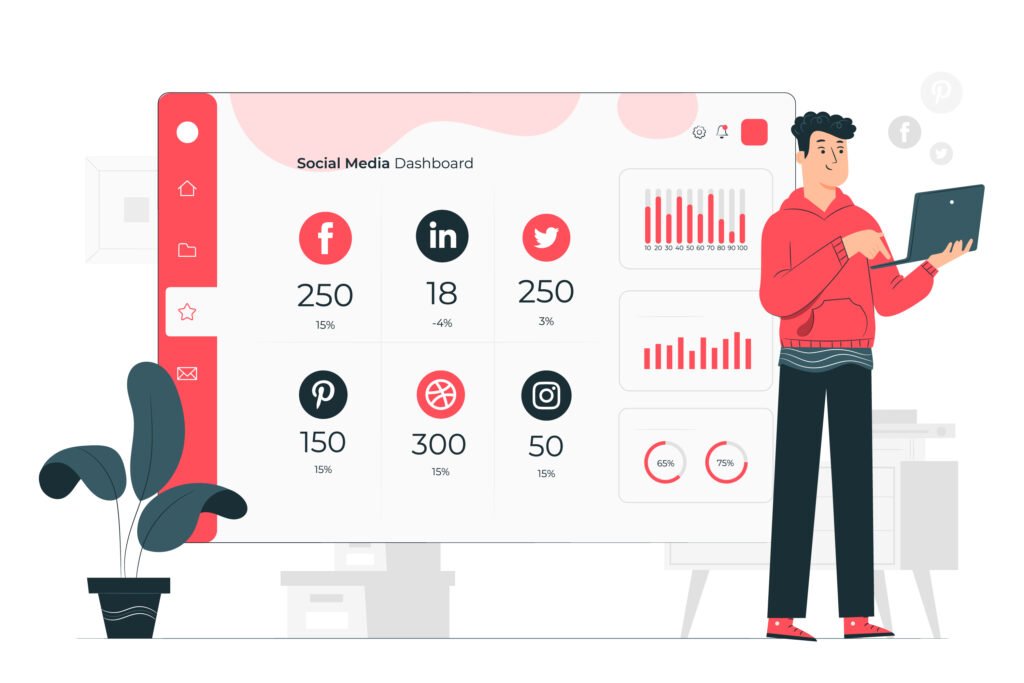
In today’s digital age, social media has become more than just a platform for connecting with friends and sharing personal updates. It has become a powerful tool for businesses to engage with their audience, gather insights, and drive sales. With billions of active users across various platforms, social media offers a goldmine of data that can be leveraged by sales and product teams to make informed decisions and stay ahead of the competition.
Social media monitoring involves tracking and analyzing conversations, mentions, and trends across different social media channels. Businesses can gain valuable insights into customer preferences, sentiment, pain points, and emerging trends by monitoring social media activity. This data can be particularly beneficial for sales and product teams, providing valuable information to optimize their strategies and offerings. This blog post, “How can social media monitoring inform your sales and product teams?” will explore how it can inform sales and product teams and help them achieve their objectives effectively.
Understanding Social Media Monitoring

Social media monitoring systematically observes and analyzes social media platforms to track mentions, conversations, and trends related to a specific brand, topic, or industry. It involves using specialized tools and techniques to gather data from various social media channels like Facebook, Twitter, Instagram, and LinkedIn.
The collected information helps businesses and organizations understand public sentiment, monitor their online reputation, identify emerging issues or crises, and gauge the effectiveness of their marketing campaigns. Social media monitoring also provides insights into audience demographics, preferences, and behavior, which can inform strategic decision-making and improve engagement strategies.
Impact Of Social Media Monitoring On Sales And Product Teams

Social media monitoring can revolutionize sales and product teams’ operations. Businesses can gain real-time product and service feedback by tracking customer conversations on Twitter, Facebook, and Instagram. This data can be invaluable for identifying consumer preferences, spotting emerging trends, and predicting future demand. Sales teams can use social media insights to tailor their pitches and strategies, while product teams can refine their offerings based on customer feedback.
Integrating social media monitoring into their workflows can help sales and product teams stay ahead of the curve, drive revenue growth, and deliver products that truly resonate with their target audience. Social media monitoring can have a significant impact on both sales and product teams in various ways:
- Customer Insights: Social media monitoring provides valuable insights into customer preferences, opinions, and behaviors. Sales teams can use this information to tailor their pitches and strategies to better meet customer needs, leading to increased sales. Product teams can gather feedback on existing products and identify areas for improvement or new product opportunities.
- Brand Reputation Management: Monitoring social media allows teams to track mentions of their brand in real-time. This enables them to promptly address negative feedback or customer issues, thus protecting the brand’s reputation. Positive sentiment can also be amplified, increasing trust and credibility and positively impacting sales.
- Competitor Analysis: By monitoring competitors’ activities and customer interactions on social media, sales and product teams can gain insights into market trends, competitive positioning, and areas of opportunity. This information can inform product development strategies and help sales teams differentiate their offerings effectively.
- Lead Generation: Social media monitoring tools can identify potential leads and prospects based on relevant keywords, discussions, or user behavior. Sales teams can then engage with these leads promptly and personally, nurturing them through the sales funnel. Similarly, product teams can identify target audiences for new product launches or feature updates.
- Customer Engagement and Support: Social media platforms provide avenues for direct communication with customers. Sales teams can engage with prospects, answer queries, and provide product information, ultimately driving conversions. Likewise, product teams can gather feedback, address customer concerns, and provide support, fostering customer satisfaction and loyalty.
- Data-Driven Decision-Making: The data collected through social media monitoring can inform strategic decision-making for both sales and product teams. Analyzing engagement rates, sentiment analysis, and demographic information can help teams refine their approaches, allocate resources effectively, and optimize their strategies for maximum impact.
- Product Innovation: By monitoring social media conversations, product teams can identify emerging trends, unmet customer needs, and dissatisfaction with existing products. This information can inspire innovation and guide the development of new features or product enhancements that resonate with customers, ultimately driving sales growth.
How Can Social Media Monitoring Inform Your Sales And Product Teams?
Let us explore how social media monitoring can inform and enhance the strategies of sales and product teams, ultimately leading to increased success and customer satisfaction.
Understanding Customer Needs and Preferences

One of the most significant benefits of social media monitoring for sales and product teams is gaining a deeper understanding of customer needs and preferences. Businesses can identify common pain points, desires, and expectations their target audience expresses by analyzing conversations and engagements on social media platforms.
This information is invaluable for sales teams, enabling them to tailor their sales pitches and offerings to address specific customer needs. By understanding what resonates with their audience, sales representatives can personalize their approach and provide solutions more likely to resonate with potential customers.
Similarly, product teams can use insights from social media monitoring to inform their product development process. Product teams can prioritize new features or enhancements that align with customer expectations by identifying recurring themes or customer requests. This proactive approach helps create products that better meet customer needs and enhances customer satisfaction and loyalty in the long run.
Monitoring Brand Perception and Reputation
Maintaining a positive brand perception is crucial for attracting and retaining customers. Social media monitoring allows sales and product teams to keep a finger on the pulse of how their brand is perceived in the market. Businesses can gauge the overall sentiment surrounding their brand and products by tracking mentions, reviews, and sentiment analysis.
Understanding brand perception is essential for sales teams to build trust and credibility with potential customers. If negative sentiments or misconceptions circulate on social media, sales representatives can address them proactively during sales conversations, mitigating potential concerns or objections.
Likewise, product teams can use insights from social media monitoring to identify areas for improvement or address any issues affecting brand perception. Whether addressing customer complaints or responding to feedback, proactive engagement on social media can help businesses maintain a positive brand reputation and foster customer loyalty.
Identifying Industry Trends and Competitive Insights

In today’s fast-paced business landscape, staying ahead of industry trends and monitoring competitor activity is crucial for maintaining a competitive edge. Social media monitoring provides sales and product teams real-time insights into emerging trends, market developments, and competitor strategies.
Businesses can identify emerging trends by tracking relevant hashtags, industry conversations, and competitor mentions and adapt their sales and product strategies accordingly. Sales teams can leverage this information to tailor their messaging and offerings to align with current market trends, thereby increasing their chances of success.
Similarly, product teams can use insights from social media monitoring to stay abreast of competitor product launches, feature updates, and customer feedback. By monitoring competitor activity, businesses can identify gaps in the market or areas where competitors may fall short, allowing them to capitalize on opportunities and differentiate their products effectively.
Enhancing Customer Engagement And Relationship Building
Social media provides a direct line of communication between businesses and their customers, making it an invaluable tool for customer engagement and relationship building. Businesses can foster stronger relationships, gather feedback, and address customer inquiries in real-time by actively engaging with customers on social media platforms.
Sales teams can use social media to engage with prospects, answer questions, and provide value-added content demonstrating expertise and thought leadership. By building rapport with potential customers on social media, sales representatives can establish trust and credibility, making converting leads into paying customers easier.
Social media is a valuable feedback loop for product teams to gather customer insights. By listening to customer feedback on social media platforms, product teams can identify product improvements or new feature development opportunities. Additionally, by engaging with customers directly on social media, product teams can demonstrate responsiveness and a commitment to customer satisfaction, which can help foster brand loyalty.
Leveraging Social Media Monitoring Tools and Technologies
To effectively harness the power of social media monitoring, businesses need access to robust tools and technologies that can analyze large volumes of social media data in real time. Fortunately, numerous social media monitoring tools in the market offer advanced analytics, sentiment analysis, and trend-tracking capabilities.
Some widespread social media monitoring tools include Hootsuite, Sprout Social, Brandwatch, and Mention. These tools allow businesses to track brand mentions, monitor sentiment, and analyze competitor activity across social media platforms. By leveraging these tools, sales and product teams can streamline their social media monitoring efforts and extract actionable insights to inform their strategies.
Frequently Asked Questions
Q1. What is social media monitoring?
Ans. Social media monitoring, also known as social media listening, involves tracking social media platforms to gather information about conversations related to a brand, product, industry, or any other topic of interest.
Q2. How can social media monitoring benefit sales teams?
Ans. Social media monitoring provides valuable insights into customer sentiment, preferences, and behavior. Sales teams can leverage this information to identify potential leads, better understand customer needs, and tailor their sales pitches accordingly.
Q3. In what ways does social media monitoring help product teams?
Ans. Product teams can use social media monitoring to gather feedback on existing products, identify emerging trends, and uncover pain points or areas for improvement. This feedback can inform product development and innovation strategies.
Conclusion
In conclusion, monitoring social media is vital in informing sales and product teams and empowering them to make data-driven decisions. Businesses can gain valuable insights into customer preferences, market dynamics, and competitor activity by analyzing conversations, monitoring brand sentiment, and tracking industry trends on social media platforms.
Social media monitoring provides a wealth of information for sales teams to personalize sales pitches, address customer concerns, and build trust with potential customers. Similarly, product teams can leverage insights from social media monitoring to inform product development, prioritize feature enhancements, and foster stronger customer relationships.
By embracing social media monitoring as a strategic tool, businesses can stay ahead of the competition, better understand their customers, and effectively drive sales and product innovation in today’s dynamic marketplace.








No Comments